The AMD 3rd Gen Ryzen Deep Dive Review: 3700X and 3900X Raising The Bar
by Andrei Frumusanu & Gavin Bonshor on July 7, 2019 9:00 AM EST** = Old results marked were performed with the original BIOS & boost behaviour as published on 7/7.
Benchmarking Performance: CPU Rendering Tests
Rendering is often a key target for processor workloads, lending itself to a professional environment. It comes in different formats as well, from 3D rendering through rasterization, such as games, or by ray tracing, and invokes the ability of the software to manage meshes, textures, collisions, aliasing, physics (in animations), and discarding unnecessary work. Most renderers offer CPU code paths, while a few use GPUs and select environments use FPGAs or dedicated ASICs. For big studios however, CPUs are still the hardware of choice.
All of our benchmark results can also be found in our benchmark engine, Bench.
Corona 1.3: Performance Render
An advanced performance based renderer for software such as 3ds Max and Cinema 4D, the Corona benchmark renders a generated scene as a standard under its 1.3 software version. Normally the GUI implementation of the benchmark shows the scene being built, and allows the user to upload the result as a ‘time to complete’.
We got in contact with the developer who gave us a command line version of the benchmark that does a direct output of results. Rather than reporting time, we report the average number of rays per second across six runs, as the performance scaling of a result per unit time is typically visually easier to understand.
The Corona benchmark website can be found at https://corona-renderer.com/benchmark
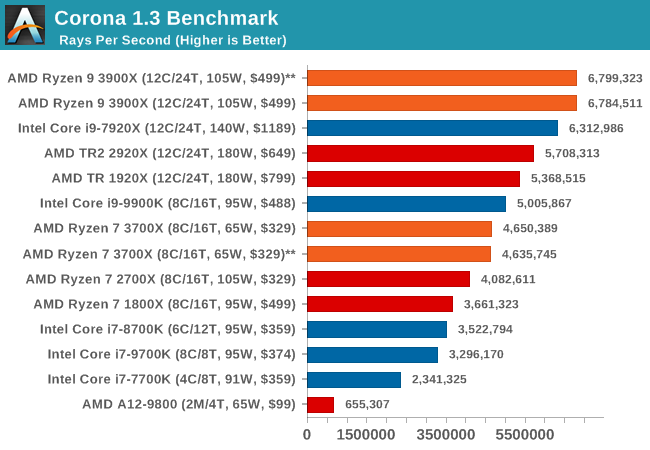
LuxMark v3.1: LuxRender via Different Code Paths
As stated at the top, there are many different ways to process rendering data: CPU, GPU, Accelerator, and others. On top of that, there are many frameworks and APIs in which to program, depending on how the software will be used. LuxMark, a benchmark developed using the LuxRender engine, offers several different scenes and APIs.

Taken from the Linux Version of LuxMark
In our test, we run the simple ‘Ball’ scene on both the C++ and OpenCL code paths, but in CPU mode. This scene starts with a rough render and slowly improves the quality over two minutes, giving a final result in what is essentially an average ‘kilorays per second’.

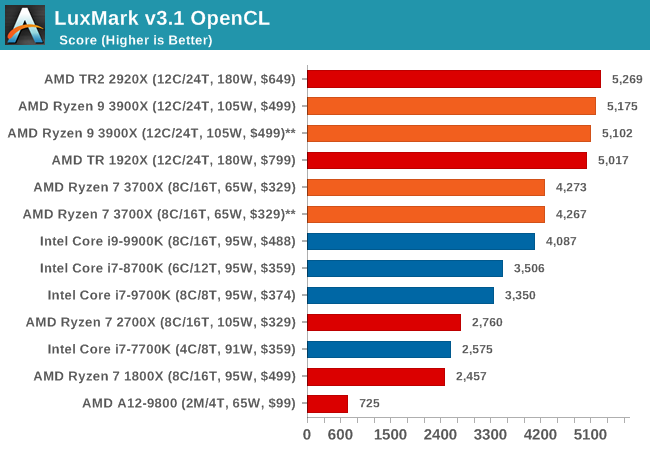
POV-Ray 3.7.1: Ray Tracing
The Persistence of Vision ray tracing engine is another well-known benchmarking tool, which was in a state of relative hibernation until AMD released its Zen processors, to which suddenly both Intel and AMD were submitting code to the main branch of the open source project. For our test, we use the built-in benchmark for all-cores, called from the command line.
POV-Ray can be downloaded from http://www.povray.org/
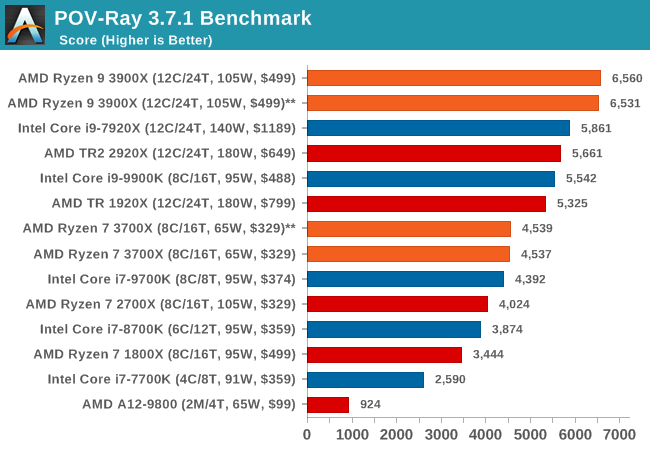
Cinebench R15
The latest version of CineBench has also become one of those 'used everywhere' benchmarks, particularly as an indicator of single thread performance. High IPC and high frequency gives performance in ST, whereas having good scaling and many cores is where the MT test wins out.
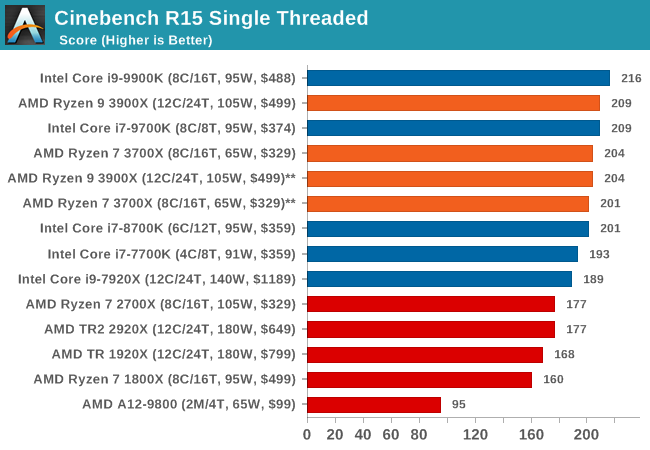
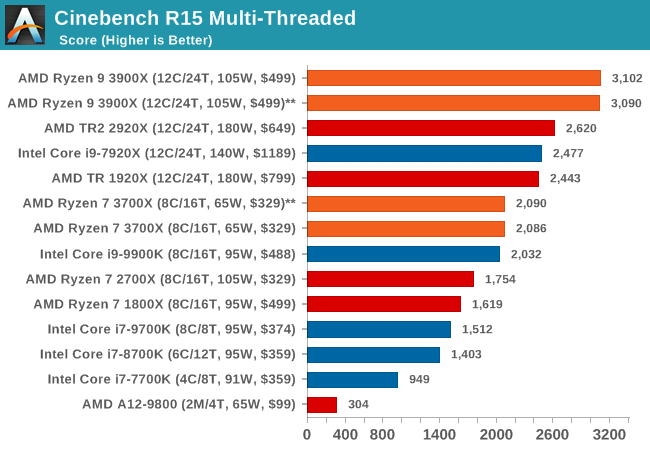











447 Comments
View All Comments
Korguz - Monday, July 22, 2019 - link
Maxiking, and HOW LONG till intel gets the SAME treatment?? saying a processor uses x watts, but in reality uses 50 to 100 watts MORE isnt FRAUD ??? hell you confine intels cpus to the watts they state, and their performance goes DOWN THE TOILET !!!. again .. you KEEP saying AMD is a fraud, but you STILL refuse to admit, that intel is a fraud as well..does this guy even acknowlege the issue with intel and the amount of power they " say " their cpus use, and how much power they REALLY use ??
Korguz - Monday, July 22, 2019 - link
further.. intel doesnt do any marketing, cause they DON'T want the general average user to know the cpu they bought, uses MORE power then has been stated, THAT also is false advertising, come on maxiking, go after intel as well, the same same things you are accusing amd of...Maxiking - Tuesday, July 23, 2019 - link
You are uneducated, TDP doesn't mean power consumption but the amount of heat dissipated, it informs you how much of heat the cooler must be able to dissipate in order to keep the cpu cool enough to run.Get it? 1700x TDP was 95W yet there were tasks it managed to consume 120 or even 140w on stock settings. Like do you even watch reviews? It was the same with 2700w.
but mimimimimimi AMD good mimimimimi Intel bad
Korguz - Tuesday, July 23, 2019 - link
sorry dude.. but YOU are uneducated, amd stays A LOT closer to its stated TDP then intel does, AT even did a review on it. power dissipated, also relates to power used. but it also doesnt help, that amd and intel both use the term TDP differently. either way.. intel uses more power then amd does.https://www.anandtech.com/show/13544/why-intel-pro...
Maxiking - Tuesday, July 23, 2019 - link
Again, TDP is not power consumption and it refers to a cooler.You are uneducated and fabricating because you are an amd fanboy. No one really cares about what is more accurate or not, because it does not say anything about power consumption of the chip.
So keep living in your nice little bubble. It is not my fault that you and other sites have been thinking that TDP -> power consumption. I will share something new to you again.. Ever heard about that Frankenstein novel? Frankenstein in not the monster but the doctor, his surname..Shocking I KNOW!!!
mimimimimimi AMD good mimimimimi Intel bad
Korguz - Tuesday, July 23, 2019 - link
again.. TDP, or Thermal Design Power, does relate to power consumption and how much is needed to keep something cool. You are uneducated and fabricating because you are an intel fanboy. i also notice you like to throw personal insults around when someone disagrees with you, or to try to make your opinion valid. so you keep living in your nice little bubble as well, not my fault you dont understand TDP relates to how much power something uses, as the more power a product uses, the more heat it creates, and then, needs to be removed.mimimimimimi intel good mimimimimi amd bad
Maxiking - Thursday, July 25, 2019 - link
What you just did it is just sad. it shows you are little kid.TDP is not power consumption, if TDP - 100% power consumption, it would mean that 100% of the electrical energy is converted into thermal energy so yeah which is impossible it would mean perpetuum mobile you twat, actually the cpu would be net positive, it would convert 100% of electrical energy into thermal whilst managing to perform another task at no energy cost.
Breaking the laws of physics just because of your AMD fanboyism
Korguz - Thursday, July 25, 2019 - link
i said it RELATES to power consumption, what, you cant read ?? cant see passed your intel bias ?? the more power something uses, the more heat it generates, and there for, the more needs to be dissipated, and i also never said anything about 100% power consumption, pulling words and making things up to try to make your self sound right ? And you are calling me names on top of that, who's the kid here ???Maxiking - Tuesday, July 23, 2019 - link
You are uneducated, TDP doesn't mean power consumption but the amount of heat dissipated, it informs you how much of heat the cooler must be able to dissipate in order to keep the cpu cool enough to run.Get it? 1700x TDP was 95W yet there were tasks it managed to consume 120 or even 140w on stock settings. Like do you even watch reviews? It was the same with 2700w.
but mimimimimimi AMD good mimimimimi Intel bad
Qasar - Tuesday, July 23, 2019 - link
hmmm doest really say amd is being fraudulent, just doesnt like the idea the chips might not boost, or run at what AMD says, but didnt mention fraud...and Korguz has a point.. WHY arent you commenting about the power intels cpus use, vs what intel says they use ?